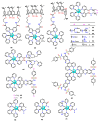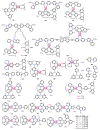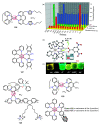Development and Application of Ruthenium(II) and Iridium(III) Based Complexes for Anion Sensing
- PMID: 36770897
- PMCID: PMC9920910
- DOI: 10.3390/molecules28031231
Development and Application of Ruthenium(II) and Iridium(III) Based Complexes for Anion Sensing
Abstract
Improvements in the design of receptors for the detection and quantification of anions are desirable and ongoing in the field of anion chemistry, and remarkable progress has been made in this direction. In this regard, the development of luminescent chemosensors for sensing anions is an imperative and demanding sub-area in supramolecular chemistry. This decade, in particular, witnessed advancements in chemosensors based on ruthenium and iridium complexes for anion sensing by virtue of their modular synthesis and rich chemical and photophysical properties, such as visible excitation wavelength, high quantum efficiency, high luminescence intensity, long lifetimes of phosphorescence, and large Stokes shifts, etc. Thus, this review aims to summarize the recent advances in the development of ruthenium(II) and iridium(III)-based complexes for their application as luminescent chemosensors for anion sensing. In addition, the focus was devoted to designing aspects of polypyridyl complexes of these two transition metals with different recognition motifs, which upon interacting with different inorganic anions, produces desirable quantifiable outputs.
Keywords: anion sensing; luminescent chemosensors; ruthenium(II)/iridium(III) complexes.
Conflict of interest statement
The authors declare no conflict of interest.
Figures





























Similar articles
-
Strategic Design of Luminescent Rhenium(I), Ruthenium(II), and Iridium(III) Complexes as Activity-Based Probes for Bioimaging and Biosensing.Chem Asian J. 2022 Nov 16;17(22):e202200840. doi: 10.1002/asia.202200840. Epub 2022 Oct 17. Chem Asian J. 2022. PMID: 36131616 Review.
-
Optical Sensing of Anions via Supramolecular Recognition with Biimidazole Complexes.Chemistry. 2017 Dec 22;23(72):18101-18119. doi: 10.1002/chem.201605782. Epub 2017 Oct 24. Chemistry. 2017. PMID: 28317177 Review.
-
Luminescent chemosensors by using cyclometalated iridium(iii) complexes and their applications.Chem Sci. 2017 Feb 1;8(2):878-889. doi: 10.1039/c6sc04175b. Epub 2016 Nov 2. Chem Sci. 2017. PMID: 28572899 Free PMC article.
-
Iridium(iii) complexes as reaction based chemosensors for medical diagnostics.Dalton Trans. 2018 Nov 21;47(43):15278-15282. doi: 10.1039/c8dt03492c. Epub 2018 Oct 1. Dalton Trans. 2018. PMID: 30270395 Review.
-
Group 9 organometallic compounds for therapeutic and bioanalytical applications.Acc Chem Res. 2014 Dec 16;47(12):3614-31. doi: 10.1021/ar500310z. Epub 2014 Nov 4. Acc Chem Res. 2014. PMID: 25369127
Cited by
-
Fine-Tuning of the Optical and Electrochemical Properties of Ruthenium(II) Complexes with 2-Arylbenzimidazoles and 4,4'-Dimethoxycarbonyl-2,2'-bipyridine.Molecules. 2023 Sep 9;28(18):6541. doi: 10.3390/molecules28186541. Molecules. 2023. PMID: 37764316 Free PMC article.
-
Quinoline conjugates for enhanced antimalarial activity: a review on synthesis by molecular hybridization and structure-activity relationship (SAR) investigation.Am J Transl Res. 2025 Feb 15;17(2):1335-1375. doi: 10.62347/TTHX6526. eCollection 2025. Am J Transl Res. 2025. PMID: 40092075 Free PMC article. Review.
-
Hydrothermal synthesis, structures, and catalytic performance of five coordination compounds driven by 5-aminoisophthalic acid.RSC Adv. 2024 Sep 3;14(38):28160-28167. doi: 10.1039/d4ra05352d. eCollection 2024 Aug 29. RSC Adv. 2024. PMID: 39228755 Free PMC article.
-
Hydrothermal Assembly, Structural Multiplicity, and Catalytic Knoevenagel Condensation Reaction of a Series of Coordination Polymers Based on a Pyridine-Tricarboxylic Acid.Molecules. 2023 Nov 8;28(22):7474. doi: 10.3390/molecules28227474. Molecules. 2023. PMID: 38005197 Free PMC article.
-
Exploring pectinolytic yeast diversity: toward effective polygalacturonase producers for applications in wine-making.FEMS Yeast Res. 2025 Jan 30;25:foae033. doi: 10.1093/femsyr/foae033. FEMS Yeast Res. 2025. PMID: 39694689 Free PMC article.
References
-
- Sessler J.L., Gale P.A., Cho W.S. Anion Receptor Chemistry. Royal Society of Chemistry; Cambridge, UK: 2006.
-
- Sessler J.L., Camiolo S., Gale P.A. Pyrrolic and polypyrrolic anion binding agents. Coord. Chem. Rev. 2003;240:17. doi: 10.1016/S0010-8545(03)00023-7. - DOI
-
- Kang S.O., Hossain M.A., Bowman-James K. Influence of dimensionality and charge on anion binding in amide-based macrocyclic receptors. Coord. Chem. Rev. 2006;250:3038–3052. doi: 10.1016/j.ccr.2006.06.006. - DOI
-
- Gale P.A., Quesada R. Anion coordination and anion-templated assembly: Highlights from 2002 to 2004. Coord. Chem. Rev. 2006;250:3219–3244. doi: 10.1016/j.ccr.2006.05.020. - DOI
-
- Gunnlaugsson T., Glynn M., Tocci G.M., Kruger P.E., Pfeffer F.M. Anion recognition and sensing in organic and aqueous media using luminescent and colorimetric sensors. Coord. Chem. Rev. 2006;250:3094–3117. doi: 10.1016/j.ccr.2006.08.017. - DOI
Publication types
Grants and funding
LinkOut - more resources
Full Text Sources

